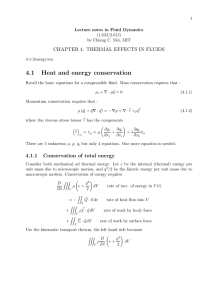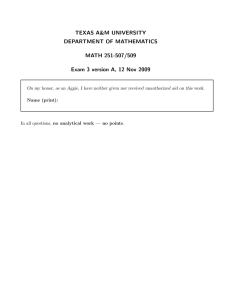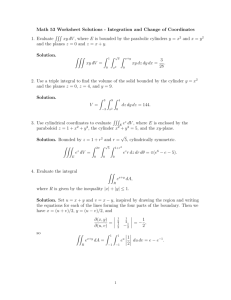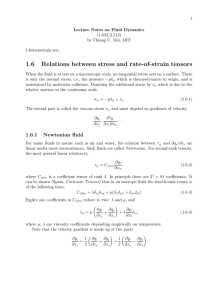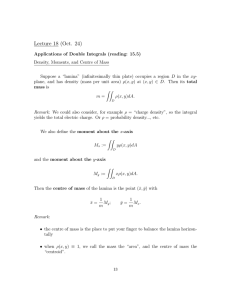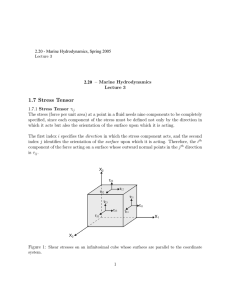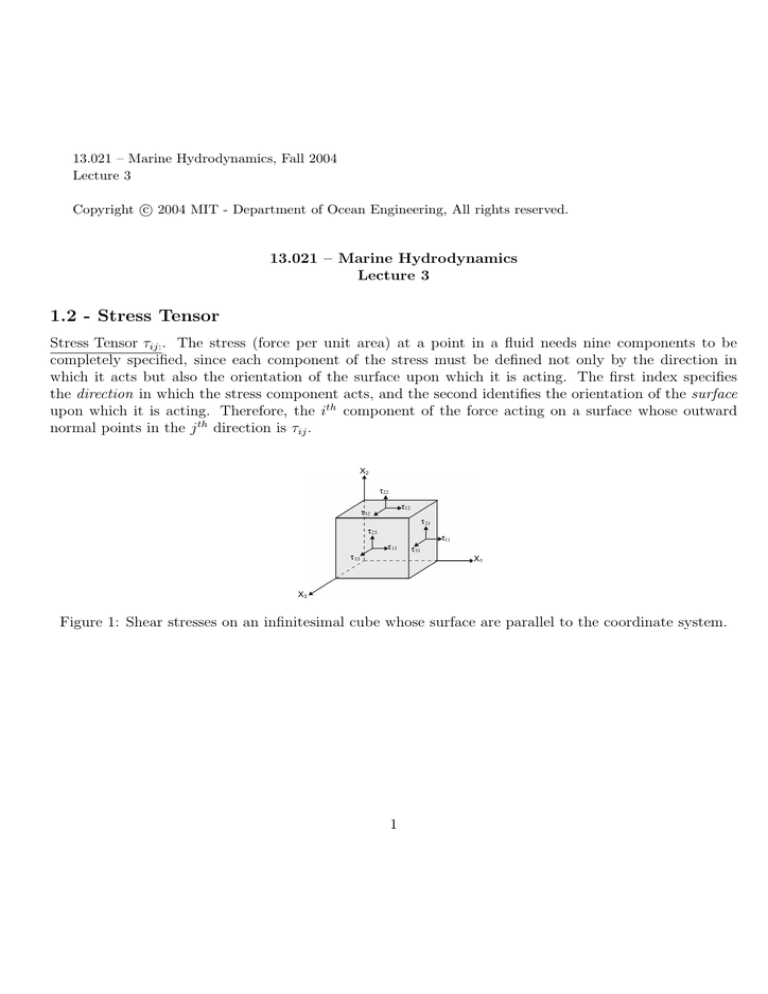
13.021 – Marine Hydrodynamics, Fall 2004
Lecture 3
c 2004 MIT - Department of Ocean Engineering, All rights reserved.
Copyright °
13.021 – Marine Hydrodynamics
Lecture 3
1.2 - Stress Tensor
Stress Tensor τij: . The stress (force per unit area) at a point in a fluid needs nine components to be
completely specified, since each component of the stress must be defined not only by the direction in
which it acts but also the orientation of the surface upon which it is acting. The first index specifies
the direction in which the stress component acts, and the second identifies the orientation of the surface
upon which it is acting. Therefore, the ith component of the force acting on a surface whose outward
normal points in the j th direction is τij .
X2
22
12
32
21
23
11
13
31
X1
33
X3
Figure 1: Shear stresses on an infinitesimal cube whose surface are parallel to the coordinate system.
1
X2
2
P
A1
n̂
1
A3
X1
Q
3
R
area A0
X3
A2
Figure 2: Consider an infinitesimal body at rest with a surface PQR that is not perpendicular to any of
the Cartesian axis. The unit normal vector to that surface is n̂ = n1 x̂1 + n2 x̂2 + n3 x̂3 . The area of the
surface = A0 , and the area of each surface perpendicular to Xi is Ai = A0 ni , for i = 1, 2, 3.
Newton’s law:
P
all4f aces
Fi = (volume force)i for i = 1, 2, 3
If δ is the typical dimension of the body
: surface forces ∼ δ 2
: volume forces ∼ δ 3
An example of surface forces is the shear force and an example of volumetric forces is the gravity force.
At equilibrium, the surface forces and volumetric forces are in balance. As the body gets smaller, the mass
of the body goes to zero, which makes
the volumetric forces equal to zero and leaving the sum of the surface
P
forces equal zero. So, as δ → 0, all4f aces Fi = 0 for i = 1, 2, 3 and ∴ τi A0 = τi1 A1 + τi2 A2 + τi3 A3 = τij Aj .
But P
the area of each surface ⊥ to Xi is Ai = A0 ni . Therefore τi A0 = τij Aj = τij (A0 nj ), where τij Aj is
the
notation (represents the sum of all components). Thus τi = τij nj for i = 1, 2, 3, where τi is the
component of stress in the ith direction on a surface with a normal ~n . We call τ i the stress vector and
we call τij the stress matrix or tensor.
Example: Pascal’s Law for hydrostatics
In a static fluid, the stress vector cannot be different for different directions of the surface normal since
there is no preferred direction in the fluid. Therefore, at any point in the fluid, the stress vector must
have the same direction as the normal vector ~n and the same magnitude for all directions of ~n .
2
Pascal’s Law: for hydrostatics
τij
no summation
z }| {
=
− (pi ) (δij )
−p1 0
0
τ = 0 −p2 0
∼
0
0 −p3
where pi is the pressure acting perpendicular to the ith surface. If po is the pressure acting perpendicular
to the surface PQR, then τi = −ni p0 , but τi = τij nj = −(pi )δij nj = −(pi )(ni ). Therefore po = pi , i =
1, 2, 3 and ~n is arbitrary.
Symmetry of the Stress Tensor
To prove the symmetry of the stress tensor we follow the steps:
j
ij
ji
ji
i
o
ij
Figure 3: Material element under tangential stress.
P
1. The
of surface forces = body forces + mass× acceleration. Assume no symmetry. Balance of
the forces in the ith direction gives:
(δ)(τij )T OP − (δ)(τij )BOT T OM = O(δ 2 ),
since surface forces are ∼ δ 2 , where the O(δ 2 ) terms include the body forces per unit depth. Then,
as δ → 0, (τij )T OP = (τij )BOT T OM .
P
of surface torque = body moment + angular acceleration. Assume no symmetry. The
2. The
balance moment with respect to o gives:
3
(τji δ)δ − (τij δ)δ = O(δ 3 ),
since the body moment is proportional to δ 3 . As δ → 0 , τij = τji .
1.3 Mass and Momentum Conservation
Consider a material volume ϑm and recall that a material volume is a fixed mass of material. A material
volume always encloses the same fluid particles despite a change in size, position, volume or surface area
over time.
1.3.1 Mass Conservation
The mass inside the material volume is:
ZZZ
M (ϑm ) =
ρdϑ
ϑm(t)
Sm(t)
ϑm ( t )
Figure 4: Material volume ϑm (t) with surface Sm (t).
Therefore the time rate of increase of mass inside the material volume is:
d
M (ϑm )
dt
=
RRR
d
dt
ϑm (t)
ρdϑ = 0,
which implies conservation of mass for the material volume ϑm .
4
1.3.2 Momentum Conservation
The velocity of fluid inside the material volume in the ith direction is denoted as ui . Linear momentum
of the material volume in the ith direction is
ZZZ
ρui dϑ
ϑm(t)
Newton’s law of motion: The time rate of change of momentum of the fluid in the material control volume
must equal the sum of all the forces acting on the fluid in that volume. Thus:
d
(momentum)i =(body force)i + (surface force)i
dt Z Z Z
ZZZ
ZZ
d
ρui dϑ =
Fi dϑ +
τij nj dS
|{z}
dt
ϑm (t)
ϑm (t)
Divergence Theorems:
Sm (t)
For vectors:
RRR
ϑ
For tensors:
RRR
ϑ
τi
RR
∇
·
~
v
dϑ
=
⊂⊃ |{z}
~v .n̂ dS
| {z }
∂vj
∂xj
S
∂τij
dϑ
∂xj
vj nj
RR
= ⊂⊃ τij nj dS
S
Thus using divergence theorems:
d
dt
RRR
ϑm(t)
ρui dϑ =
RRR ³
ϑm(t)
Fi +
∂τij
∂xj
´
dϑ,
which gives the conservation of the momentum for the material volume ϑm .
1.4 Kinematic Transport Theorems
Consider a flow through some moving control volume ϑ(t) during a small time interval ∆t. Let f (~x, t)
be any (Eulerian) fluid property per unit volume of fluid (e.g. mass, momentum, etc.). Consider the
integral
5
ZZZ
I(t) =
f (~x, t) dϑ
ϑ(t)
According with the definition of the derivative, we can write
d
I(t + ∆t) − I(t)
I(t) = lim
∆t→0
dt
∆t
Z Z Z
ZZZ
1
= lim
f (~x, t + ∆t)dϑ −
f (~x, t)dϑ
∆t→0 ∆t
ϑ(t+∆t)
ϑ(t)
S(t+∆t)
ϑ ( t + ∆t )
ϑ( t )
S(t)
Figure 5: Control volume ϑ and its bounding surface S at instants t and t + ∆t.
Next, we consider the steps
1. Taylor series expansion of f about t.
f (~x, t + ∆t) = f (~x, t) + ∆t
2.
RRR
dϑ =
ϑ(t+∆t)
RRR
ϑ(t)
dϑ +
RRR
∆ϑ
dϑ where
RRR
∆ϑ
dϑ =
RR
S(t)
of S(t).
6
∂f
(~x, t) + O((∆t)2 )
∂t
[Un (~x, t)∆t] dS and Un (~x, t) is the normal velocity
S(t+∆t)
S(t)
U n ( x, t )∆t + O( ∆t ) 2
dS
Figure 6: Element of the surface S at instants t and t + ∆t.
So we have
Z Z Z
d
1
I(t) = lim
∆t→0 ∆t
dt
ZZZ
dϑf + ∆t
ϑ(t)
dϑ
∂f
+ ∆t
∂t
ϑ(t)
ZZ
ZZZ
dϑf + O(∆t)2
dSUn f −
S(t)
ϑ(t)
Kinematic Transport Theorem (KTT) ∼ Leibnitz rule in 3D
d
dt
RRR
f (~x, t)dϑ =
ϑ(t)
RRR
ϑ(t)
∂f (~
x,t)
dϑ
∂t
+
RR
f (~x, t)Un (~x, t)dS
S(t)
If the control volume is a material volume: ϑ(t) = ϑm (t) and Un = ~v · n̂, where ~v is the fluid particle
velocity. Then the Kinematic Transport theorem (KTT) assume the form
ZZZ
ZZZ
ZZ
d
∂f (~x, t)
f (~x, t)dϑ =
dϑ +
f (~x, t)(~v · n̂) dS
|
{z
}
dt
∂t
ϑm (t)
ϑm (t)
Sm (t) f vi ni (Einstein
Notation)
Using the divergence theorem:
ZZZ
ϑ
ZZ
∇
~}dϑ = ⊂⊃ |{z}
α
~ · n̂dS
| {z· α
∂
α
∂xi i
S
1st Kinematic Transport Theorem (KTT)
7
αi n i
(1)
RRR
d
dt
ϑm (t)
f (~x, t) dϑ =
RRR ∂f (~x,t)
dϑ,
+
∇
·
(f~
v
)
∂t
| {z }
ϑm (t)
∂
(f vi )
∂xi
where f is a fluid property per unit volume.
1.5 Continuity Equation
Let the fluid property per unit volume be mass per unit volume ( f = ρ)
¸
ZZZ
ZZZ ·
d
∂ρ
0
=
ρdϑ =
+ ∇ · (ρ~v ) dϑ
↑
↑
dt
∂t
conservation
of mass
1st
ϑm (t)
KTT ϑm (t)
since ϑm is arbitrary, so the integrand ≡ 0 everywhere. Therefore, the differential form of conservation
of mass i.e. Continuity equation follows:
∂ρ
+ ∇ · (ρ~v ) = 0
∂t
∂ρ
+ [~v · ∇ρ + ρ∇ · ~v ] = 0
|∂t {z
}
Dρ
Dt
Therefore,
Dρ
Dt
+ ρ∇ · ~v = 0
In general, ρ = ρ(p, T, . . .). We consider the special case of incompressible flow (Note, the density of
the entire flow is not constant when we have more than one fluid, like water and oil, as illustrated in the
picture above).
8
Constant ρ
fluid particle
ρ2
fluid particle
ρ1
oil
water
Figure 7: Interface of two fluids (oil-water)
Therefore, for an incompressible flow:
Dρ
Dt
=0
∂vi
Then ∇ · ~v or
= 0, which is the Continuity equation for incompressible fluid.
∂x
|
{z i }
rate of volume dilatation
1.6 Euler’s Equation (differential form of conservation of momentum)
2nd Kinematic Transport Theorem ( = 1st KTT + continuity equation). If G = fluid property per unit
mass, then ρG = fluid property per unit volume
d
dt
ZZZ ·
ZZZ
ρGdϑ =
ϑm (t)
ϑm (t)
¸
∂
(ρG) + ∇ · (ρG~v ) dϑ
∂t
ZZZ
G
=
ϑm (t)
µ
¶
∂ρ
+ ∇ · ρ~v
∂t
|
{z
}
µ
¶
∂G
+ρ
+ ~v · ∇G
dϑ,
∂t
|
{z
}
0 from mass conservation
and the 2nd Kinematic Transport Theorem (KTT) follows:
d
dt
RRR
ρGdϑ =
ϑm
RRR
ϑm
9
ρ DG
dϑ
Dt
DG
Dt
Application:
We consider G as the ith momentum per unit mass ( vi ). Then,
¶
ZZZ µ
ZZZ
∂τij
d
Fi +
dϑ
=
ρvi dϑ
↑
∂xj
dt
ϑm (t)
conservation
of momentum
ϑm (t)
ZZZ
=
↑
2nd
KTT ϑm (t)
ρ
Dvi
dϑ
Dt
But ϑm (t) is an arbitrary material volume, therefore the integral identity gives Euler’s equation
∂v
i
i
ρ Dv
≡ ρ
∇vi
= Fi +
Dt
∂t + ~|v ·{z
}
∂τij
,
∂xj
∂v
vj ∂xi
j
and its Vector Tensor Form
v
≡ρ
ρ D~
Dt
¡ ∂~v
∂t
¢
+ ~v · ∇~v = F~ + ∇ · τ
∼
10

